#CMB observatory
Text
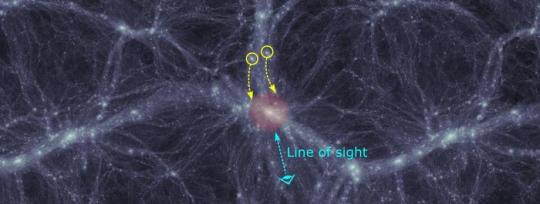

Motion of satellite galaxies suggests younger universe
In standard cosmological models, the formation of cosmological structures begins with the emergence of small structures, which subsequently undergo hierarchical merging, leading to the formation of larger systems. As the Universe ages, massive galaxy groups and clusters, being the largest systems, tend to increase in mass and reach a more dynamically relaxed state.
The motions of satellite galaxies around these groups and clusters provide valuable insights into their assembly status. The observations of such motion offer crucial clues about the age of the Universe.
By using public data from the Sloan Digital Sky Survey (SDSS), a research team led by Prof. GUO Qi from the National Astronomical Observatories of the Chinese Academy of Sciences (NAOC) analyzed the kinematics of satellite pairs around massive galaxy groups. The team's findings suggest that the Universe may be younger than predicted by the LCDM model with Planck cosmological parameters.
This study was published in Nature Astronomy on Jan. 22.
The researchers investigated the movement of satellite pairs positioned on the opposite side of massive galaxy groups by using their velocity offsets from the central galaxy along the line of sight. They discovered a notable excess of pairs exhibiting correlated velocity offsets compared to pairs displaying anti-correlated velocity offsets.
"The excess of correlated satellite pairs suggests the presence of recently accreted or infalling satellite galaxies," said Prof. GUO Qi, the corresponding author of the paper.
This excess was also found in up-to-date cosmological simulations but the magnitude of this effect was considerably lower than in observations. The significant discrepancy between the observations and simulations implies that massive galaxy groups are younger in the real Universe.
"Since the age of the massive galaxy groups could be closely related to the age of the Universe, these findings consequently suggest a younger Universe compared to that derived from the cosmic microwave background (CMB) by the Planck Collaboration," said Dr. GU Qing, first author of the paper.
These findings present a challenge to the current cosmological model and may provide valuable insights into the Hubble tension problem.
TOP IMAGE....Galaxies falling into a massive galaxy group. Upon entering the group, these galaxies exhibit a blueshift in comparison to the central galaxy. Credit: Dr. LIAO Shihong
LOWER IMAGE....The accumulative fraction of correlated pairs as a function of tolerance angle. Credit: Dr. GU Qing
6 notes
·
View notes
Text
Cosmic Interface: Technologies to Tap into the Reservoir Universe's Computational Fabric

Developing technologies to interact with the computational subsystems of the "Reservoir Universe" would be profoundly transformative, potentially providing unprecedented insights into the universe's inner workings. Here are some speculative technologies and methodologies that could be envisioned to interface with these computational nodes:
1. Quantum Information Decoders
Purpose: Decode the information processed by the computational subsystems of the universe.
Operation:
Quantum Entanglement: Leverage quantum entanglement to link with the subsystems.
Quantum Sensors: Use highly sensitive quantum sensors to detect subtle changes in quantum field amplitudes.
Decoding Algorithms: Develop algorithms that can interpret the encoded data streams into meaningful information.
2. Gravitational Wave Analyzers
Purpose: Detect and interpret data embedded in gravitational waves.
Operation:
Network of Detectors: Deploy a global network of gravitational wave detectors, like LIGO, VIRGO, and KAGRA, but more sensitive.
Waveform Analysis Algorithms: Utilize machine learning algorithms to identify patterns and extract computational data.
Feedback Mapping: Map the gravitational wave feedback loops to understand the computational processes of spacetime curvature.
3. Cosmic Neutrino Networks
Purpose: Use neutrinos as messengers to probe computational nodes.
Operation:
Neutrino Emitters and Receivers: Create devices capable of emitting and detecting neutrinos at extremely high precision.
Neutrino Field Analysis: Analyze how neutrinos interact with different subsystems, revealing computational processes.
Interference Patterns: Study interference patterns to map the structure of computational networks.
4. Spacetime Curvature Probes
Purpose: Measure and manipulate the local curvature of spacetime to interact with computational nodes.
Operation:
Micro-Gravity Sensors: Develop ultra-sensitive sensors to detect minute changes in spacetime curvature.
Localized Curvature Manipulation: Use high-energy particle colliders or gravitational lensing to alter local spacetime curvature.
Curvature Mapping Algorithms: Create algorithms that translate curvature changes into computational data.
5. Quantum Field Manipulators
Purpose: Directly manipulate quantum fields to interact with computational subsystems.
Operation:
Field Generators: Design devices that can generate controlled quantum fields.
Field Interaction Analysis: Analyze how the generated fields interact with cosmic quantum fields.
Quantum State Alteration: Modify the quantum probabilities to influence computational outputs.
6. Cosmic Neural Networks
Purpose: Create AI systems that model and interface with the computational fabric.
Operation:
Neural Network Architecture: Develop neural network architectures that mimic the hypothesized cosmic computational nodes.
Training on Cosmic Data: Train these networks using real cosmic data from telescopes, particle detectors, and gravitational wave observatories.
Pattern Recognition: Recognize patterns in cosmic data that might reveal computational structures.
7. Information Entropy Analyzers
Purpose: Measure the entropy changes in cosmic information processing.
Operation:
Entropy Sensors: Build sensors that detect changes in cosmic microwave background (CMB) radiation or cosmic rays.
Entropy Mapping Algorithms: Use machine learning to map entropy variations across different cosmic regions.
Subsystem Identification: Identify computational subsystems based on entropy changes.
8. Multidimensional Signal Processors
Purpose: Detect and analyze signals from higher-dimensional spaces.
Operation:
Dimensional Probes: Construct probes capable of detecting multidimensional signals based on string theory or M-theory frameworks.
Signal Interpretation Algorithms: Develop algorithms to interpret these signals into meaningful computational data.
Higher-Dimensional Mapping: Map out the structure of higher-dimensional computational networks.
9. Virtual Reality Interfaces
Purpose: Create immersive environments to visualize and interact with the computational fabric.
Operation:
Cosmic Data Visualization: Use virtual reality (VR) to visualize cosmic data from computational nodes.
Interactive Simulations: Build simulations that allow users to explore and manipulate the computational subsystems.
Feedback Mechanisms: Provide real-time feedback based on changes in the cosmic computational network.
Conclusion
Interfacing with the computational fabric of the universe would require a multidisciplinary approach, combining quantum mechanics, information theory, cosmology, and advanced computing. Although speculative, these technologies offer a glimpse into how humanity might one day unlock the secrets of the Reservoir Universe and gain a deeper understanding of the cosmos and our place within it.
#CosmicInterface#ReservoirUniverse#ComputationalFabric#QuantumTechnology#GravitationalWaveAnalysis#CosmicNeutrinoNetworks#SpacetimeCurvatureProbes#QuantumFieldManipulators#CosmicNeuralNetworks#InformationEntropyAnalysis#MultidimensionalSignals#VirtualRealitySpace#CosmicComputing
0 notes
Text
Cutting-Edge Cosmic Microwave Background Observatory Hits South Pole Stumbling Block
CMB science had an unassuming beginning six decades ago, when scientists in New Jersey spied a signal so weird that they at first believed it was …
View On WordPress
0 notes
Link
In the coming decade, multiple space agencies and commercial space providers are determined to return astronauts to the Moon and build the necessary infrastructure for long-duration stays there. This includes the Lunar Gateway and the Artemis Base Camp, a collaborative effort led by NASA with support from the ESA, CSA, and JAXA, and the Russo-Chinese International Lunar Research Station (ILRS). In addition, several agencies are exploring the possibility of building a radio observatory on the far side of the Moon, where it could operate entirely free of radio interference. For years, researchers have advocated for such an observatory because of the research that such an observatory would enable. This includes the ability to study the Universe during the early “Cosmic Dark Ages,” even before the first stars and galaxies formed (about 50 million years after the Big Bang). While there have been many predictions about what kind of science a lunar-based radio observatory could perform, a new research study from Tel Aviv University has predicted (for the first time) what groundbreaking results this observatory could actually obtain. This study was led by Prof. Rennan Barkana and Dr. Rajesh Mondal, an astrophysics professor and a postdoctoral researcher (respectively) with the School of Physics and Astronomy at Tel Aviv University. The paper that describes their conclusions, “Prospects for precision cosmology with the 21 cm signal from the dark ages,” has been published in Nature Astronomy. As they argue, the study’s findings show that the measured radio signals can be used to test the Standard Model of Cosmology and determine the composition of the Universe. Artist’s impression of a radio telescope on the far side of the Moon. Credit: Made with DALLE The Cosmic Dark Ages, which occurred roughly 130,000 to 1 billion years after the Big Bang, has traditionally remained elusive to astronomers (hence the name). Essentially, light from this cosmological period is redshifted to the point where it is only visible in the radio spectrum. What’s more, the only sources of photons from this period are the remnant radiation from the Big Bang – which is visible today as the Cosmic Microwave Background (CMB) – or are visible as the 21 cm line (or hydrogen line) caused by the reionization of neutral hydrogen. These radio waves can only be studied from space, where they are free of atmospheric interference and other radio sources. On the far side of the Moon, a radio observatory would also be safe from radio interference caused by our Sun. Establishing an observatory there would still be a major challenge. As Prof. Barkana explained in a recent Tel Aviv University statement: “NASA’s new James Webb space telescope discovered recently distant galaxies whose light we receive from the cosmic dawn, around 300 million years after the Big Bang. Our new research studies an even earlier and more mysterious era: the cosmic dark ages, only 50 million years after the Big Bang. Conditions in the early Universe were quite different from today. “The new study combines current knowledge of cosmic history with various options for radio observations, in order to reveal what can be discovered. Specifically, we computed the intensity of radio waves as determined by the density and temperature of the hydrogen gas at various times, and then showed how the signals can be analyzed in order to extract from them the desired results.” Expansion of the Universe (Credit: NASA/WMAP Science Team) For astronomers hoping to push the boundaries of cosmology, the Cosmic Dark Ages offer an opportunity to study the first stars and galaxies in the Universe. For their study, Barkana and Mondal argue that a lunar radio observatory could measure radio signals to determine the composition of the early Universe, the expansion rate of the cosmos (thereby testing the theory of Dark Energy), and perhaps gain insight into the mystery of Dark Matter. These are all integral to the Standard Model of Cosmology, known as the Lambda-Cold Dark Matter (LCDM) model. They also found that with an array consisting of multiple radio antennas, scientists could accurately measure the amount of hydrogen and helium shortly after the Big Bang. A precise determination of both would reveal valuable information on how ordinary matter formed from hydrogen, which fueled the creation of the first stars, gradually giving rise to heavier elements, planets, and eventually life. Last, they found that with an even larger array of lunar antennas, it will also be possible to measure the weight of cosmic neutrinos – a critical parameter in developing physics beyond the Standard Model of Particle Physics. As Prof. Barkana concluded: “When scientists open a new observational window, surprising discoveries usually result. With lunar observations, it may be possible to discover various properties of dark matter, the mysterious substance that we know constitutes most of the matter in the Universe, yet we do not know much about its nature and properties. Clearly, the cosmic dark ages are destined to shed new light on the Universe.” Further Reading: EurekAlert, Nature The post A Radio Telescope on the Moon Could Help Us Understand the First 50 Million Years of the Universe appeared first on Universe Today.
0 notes
Text
Particle Physicists Put Forward Research Priorities for Coming Decade - Technology Org
New Post has been published on https://thedigitalinsider.com/particle-physicists-put-forward-research-priorities-for-coming-decade-technology-org/
Particle Physicists Put Forward Research Priorities for Coming Decade - Technology Org
A panel of the nation’s top particle physicists, chaired by University of California, Berkeley, theoretician Hitoshi Murayama, has issued its final report recommending how the U.S. government should commit its high-energy physics research funds for the next decade and beyond, focusing on neutrinos, dark matter and the cosmic microwave background.
The cover graphic of the P5 report illustrates how discoveries in the quantum realm (left) combined with observations of the hidden universe (right) can intersect to uncover new physics. Image credit: American Physical Society
The report by the Particle Physics Project Prioritization Panel (P5) was approved by the High Energy Physics Advisory Panel (HEPAP) and will be sent to the two main funding agencies for physics in the U.S. — the Department of Energy (DOE) and the National Science Foundation (NSF) — to aid them in their decisions about which research to fund. The HEPAP, a permanent advisory committee to DOE and NSF, constitutes a prioritization panel every 10 years.
The panel, consisting of 31 members and one ex-officio member from the U.S. and abroad, considered only large- and medium-sized physics research projects — the kind that can take years or decades to plan and build, enlist contributions from thousands of scientists and cost billions of dollars.
Above-ground portion of the IceCube Neutrino Observatory at the South Pole. The experiment currently consists of strings of detectors embedded in 1 cubic kilometer of ice. The planned IceCube-Gen2 would have many more detectors and 10 times the sensitivity to neutrinos. Image courtesy of the IceCube collaboration
To fit within budget constraints — likely less than $5 billion from the two agencies over 10 years for new projects — the panel had to combine or reconfigure many proposed projects and turn down perhaps two-thirds of them.
“Fiscal responsibility has been a big thing on our mind to make sure that the recommendations are actionable by agencies and can be followed up,” said Murayama, the MacAdams Professor of Physics at the UC Berkeley. “We had to be really realistic about our plan.”
The five recommended projects with estimated budgets exceeding a quarter of a billion dollars each are:
The Cosmic Microwave Background Stage IV experiment (CMB-S4), which will use telescopes sited in Chile and Antarctica, supported by U.S. infrastructure at the South Pole, to study the oldest light from the beginning of the universe. The polarization of the CMB can tell cosmologists about the gravitational waves generated during inflation in the early universe and help them understand what was going on when the cosmos was still microscopic.
Enhancements, including an upgrade in power and experimental capabilities, to the Deep Underground Neutrino Experiment (DUNE) in South Dakota. The DUNE is the centerpiece of a decades-long program to reveal the mysteries of elusive neutrinos. The U.S.-hosted international project will exploit a unique underground laboratory, the Sanford Underground Research Laboratory, now nearing completion, and neutrino beams produced at Fermi National Accelerator Laboratory in Illinois.
A Higgs boson factory, located in either Europe or Japan, to advance studies of a still mysterious particle that was only discovered in 2012, yet which gives mass to all other forms of matter. An accelerator that produces lots of Higgs bosons would allow precise measurements of the boson’s properties and help physicists understand how the particle fits into current models of the universe and whether it is connected with dark matter.
A Generation 3 (G3) Dark Matter experiment that would combine four different international experiments — including the LZ experiment led by Lawrence Berkeley National Laboratory — into one comprehensive program to probe the enigmatic nature of dark matter, which makes up a significant portion of the universe’s mass and energy and has been one of the most enduring mysteries in modern physics. The panel recommended that this experiment be built in the U.S.
Expansion at the South Pole of a neutrino observatory, which earlier this year mapped for the first time the sources of neutrinos from the Milky Way galaxy and outside our galaxy. Called IceCube-Gen2, it would be an international collaboration operated by the University of Wisconsin–Madison. The observatory now consists of detectors embedded in 1 cubic kilometer of ice; the expansion would increase the observatory’s sensitivity by a factor of 10.
The panel also recommended investing in studies of a future muon collider. While most particle accelerators today rev up electrons or protons and smash them together, a muon collider would accelerate short-lived muons, which are fundamental particles like electrons (they’re both leptons), but much heavier.
A muon collider could explore new frontiers of physics with much less energy input than a proton collider. The panel proposed Fermilab as a good place to build a demonstration collider to test the unique technology.
“In the P5 exercise, it’s really important that we take this broad look at where the field of particle physics is headed, to deliver a report that amounts to a strategic plan for the U.S. community with a 10-year budgetary timeline and a 20-year context. The panel thought about where the next big discoveries might lie and how we could maximize impact within budget to support future discoveries and the next generation of researchers and technical workers who will be needed to achieve them,” said Karsten Heeger, P5 panel deputy chair and Eugene Higgins Professor and chair of physics at Yale University.
The panel also urged DOE to establish a fund, like NSF, that would support small-scale projects.
“We need to really look at the balance between big things — of course, we’re all excited about them — but also small things, to really keep young people going,” Murayama said.
“In some cases, small projects can involve thinking really outside the box and can be high-risk, high-return, in terms of scientific results. That kind of combination we feel very strongly about.”
The panel was also tasked with looking at diversity issues within the particle physics community.
“We came up with actionable recommendations for how we can improve the climate in the community, which is still very much dominated by white males. I hate to say this, but that’s true,” Murayama said.
“One of the big discussions we had was about how to make the community more inclusive and mutually caring for each other. We have clear recommendations along those lines.”
The report built on the output of a Snowmass 2021 high energy physics community planning exercise in Seattle, Washington, organized by the American Physical Society, the only independent body in the U.S. that represents particle physics community as a whole. The new knowledge and new technologies discussed there set the stage for the P5 report.
“The Higgs boson had just been discovered before the previous P5 process, and now our continued study of the particle has greatly informed what we think may lie beyond the standard model of particle physics,” Murayama said.
“Our thinking about what dark matter might be has also changed, forcing the community to look elsewhere — to the cosmos. And in 2015, the discovery of gravitational waves was reported. Accelerator technology is changing, too, which has shifted the discussion to the technology R&D needed to build the next-generation particle collider.”
He noted that the two triangles on the cover of the report are meant to emphasize that looking at smaller and smaller things — the realm of traditional particle physics — must be combined with a look at larger structures, such as the evolution of universe, to get a complete picture of what the report describes as the “smallest constituents of our vast and complex universe.”
“The P5 report will lay the foundation for a very bright future in the field,” said R. Sekhar Chivukula, 2023 chair of the APS Division of Particles and Fields and a Distinguished Professor of Physics at the University of California, San Diego.
“There are extraordinarily important scientific questions remaining in particle physics, which the U.S. particle physics community has both the capability and opportunity to help address, within our own facilities and as a member of the global high energy physics community.”
Source: UC Berkeley
You can offer your link to a page which is relevant to the topic of this post.
#2023#accelerators#amp#Antarctica#background#billion#box#budgets#climate#Collaboration#Community#comprehensive#cosmos#course#Dark#dark matter#Discoveries#diversity#electrons#energy#Energy & fuel news#Europe#Evolution#Exercise#experimental#Facilities#factor#Fermi#Forms#Foundation
0 notes
Video
youtube
25 SINAIS MISTERIOSOS DETECTADOS DO ESPAÇO PROFUNDO
ASSINE JÁ O SPACE TODAY PLUS E TENHA ACESSO A CENTENAS DE CONTEÚDOS INÉDITOS E EM PORTUGUÊS SOBRE ASTRONOMIA E ASTRONÁUTICA POR APENAS R$29,90 POR MÊS!!! https://quero.plus OUÇA O PODCAST HORIZONTE DE EVENTOS: https://www.spreaker.com/episode/52441779 Assim como as Ondas Gravitacionais (GWs) e as Explosões de Raios Gama (GRBs), as Explosões Rápidas de Rádio (FRBs) são um dos fenômenos astronômicos mais poderosos e misteriosos da atualidade. Esses eventos transitórios consistem em rajadas que liberam mais energia em um milissegundo do que o Sol em três dias. Embora a maioria das rajadas dure apenas milissegundos, houve casos raros em que FRBs foram encontrados repetindo. Embora os astrônomos ainda não tenham certeza do que os causa e as opiniões variem, observatórios dedicados e colaborações internacionais aumentaram drasticamente o número de eventos disponíveis para estudo. Um dos principais observatórios é o Canadian Hydrogen Intensity Mapping Experiment (CHIME), um radiotelescópio de última geração localizado no Dominion Radio Astrophysical Observatory (DRAO) em British Columbia, Canadá. Graças ao seu grande campo de visão e ampla cobertura de frequência, este telescópio é uma ferramenta indispensável para detectar FRBs (mais de 1000 fontes até o momento!) Usando um novo tipo de algoritmo, a Colaboração CHIME/FRB encontrou evidências de 25 novas FRBs repetidas em Dados do CHIME detectados entre 2019 e 2021. Apesar de sua natureza misteriosa, os FRBs são onipresentes e as melhores estimativas indicam que os eventos chegam à Terra cerca de mil vezes por dia em todo o céu. Nenhuma das teorias ou modelos propostos até agora pode explicar completamente todas as propriedades das rajadas ou das fontes. Embora se acredite que alguns sejam causados por estrelas de nêutrons e buracos negros (atribuíveis à alta densidade de energia de seus arredores), outros continuam a desafiar a classificação. Por causa disso, outras teorias persistem, variando de pulsares e magnetares a GRBs e comunicações extraterrestres. O CHIME foi originalmente projetado para medir a história da expansão do Universo através da detecção de hidrogênio neutro. Aproximadamente 370.000 anos após o Big Bang, o Universo foi permeado por esse gás, e os únicos fótons eram a radiação relíquia do Big Bang – o Cosmic Microwave Background (CMB) – ou o liberado por átomos neutros de hidrogênio. Por esta razão, astrônomos e cosmólogos referem-se a este período como a “Idade das Trevas”, que terminou cerca de 1 bilhão de anos após o Big Bang, quando as primeiras estrelas e galáxias começaram a reionizar o hidrogênio neutro (a Era da Reionização). Especificamente, o CHIME foi projetado para detectar o comprimento de onda da luz que o hidrogênio neutro absorve e emite, conhecido como linha de hidrogênio de 21 cent��metros . Dessa forma, os astrônomos poderiam medir a velocidade com que o Universo estava se expandindo durante a “Idade das Trevas” e fazer comparações com eras cosmológicas posteriores que são observáveis. No entanto, o CHIME provou ser ideal para o estudo de FRBs, graças ao seu amplo campo de visão e à faixa de frequências que cobre (400 a 800 MHz). Este é o propósito da Colaboração CHIME/FRB, que é detectar e caracterizar FRBs e rastreá-los até suas fontes. Como Dunlap Postdoctoral Fellow e principal autor Ziggy Pleunis disse ao Universe Today, cada FRB é descrito por sua posição no céu e uma quantidade conhecida como Medida de Dispersão (DM). Isso se refere ao atraso de tempo de altas para baixas frequências causado pelas interações da rajada com o material enquanto ele viaja pelo espaço. Em um artigo divulgado em agosto de 2021, a Colaboração CHIME/FRB apresentou o primeiro catálogo de grandes amostras de FRBs contendo 536 eventos detectados pelo CHIME entre 2018 e 2019, incluindo 62 rajadas de 18 fontes repetidas relatadas anteriormente. Essas descobertas podem ajudar a informar pesquisas futuras, que se beneficiarão dos radiotelescópios de próxima geração que se tornarão operacionais nos próximos anos. Isso inclui o Square Kilometer Array Observatory (SKAO), que deve reunir sua primeira luz em 2027. Localizado na Austrália, este telescópio de 128 pratos será fundido com o MeerKAT na África do Sul para criar o maior radiotelescópio do mundo. Enquanto isso, a taxa prodigiosa na qual novos FRBs estão sendo detectados (incluindo eventos repetidos) pode significar que os astrônomos de rádio podem estar perto de um avanço! FONTE:: https://www.universetoday.com/159813/astronomers-find-25-fast-radio-bursts-that-repeat-on-a-regular-basis/ https://arxiv.org/pdf/2301.08762.pdf #RADIO #UNIVERSE #MISTERY
0 notes
Text
What is interstellar space and where does it begin?
Interstellar space is the area between the stars, but it is far from empty. It contains vast quantities of neutrinos, charged particles, atoms, molecules, dark matter and photons ranging from the highest-energy radiation to the sluggish light of the cosmic microwave background (CMB) albeit rather sparsely spread out.
According to the National Radio Astronomy Observatory (NRAO), the average…

View On WordPress
0 notes
Text
UK universities join mission to discover the origin of the universe
UK universities join mission to discover the origin of the universe
The UK has joined an international mission to try and understand the first moments of the universe just fractions of a second after it came into existence.
Six UK universities will help to deliver a major upgrade to the cosmic microwave background (CMB) experiment known as Simons Observatory (SO).
The SO is located in the high Atacama Desert in Northern Chile inside the Chajnator Science…
View On WordPress
0 notes
Video
vimeo
Original caption:
The South Pole is one of the coldest, driest and harshest places on earth. The Aurora Australis can be seen together with the core of the milkyway only here in Antarctica. Temperatures below -70°C/-95°F during the polar night are not uncommon. Together with strong winds and exceptional aridity this is one of the hardest places to shoot timelapse in. Special equipment has been constructed and modified to keep the cameras running.
Read more about it here: antarctic-adventures.de/
Shot by Robert Schwarz, CMB-Observatory (Cosmic Microwave Backgroud) operator and technician at the Amundsen–Scott South Pole Station.
Post-Production, Edit and Stock-footage management by Martin Heck, Timestorm Films
Curated by Christoph Malin and Martin Heck
Production coordination by Christoph Malin
timestormfilms.com
Music by Tony Anderson licensed through musicbed:
share.mscbd.fm/martinheck
Edited with Adobe LR, AE, Davinci Resolve and LRTimelapse:
lrtimelapse.com/
Shot on Canon 6D and 5DIII cameras
#Timelapse#south pole#antarctica#cold#frozen#night sky#dark sky#CMB observatory#amundsen#scott#video#vimeo#travel#milky way#galaxy#night#polar#the earth story
87 notes
·
View notes
Text
WHAT IS THE STEADY STATE THEORY??
Blog#67 Wednesday, March 3rd ,2021
Welcome back,
The Big Bang theory states that the Universe originated from an incredibly hot and dense state 13.7 billion years ago and has been expanding and cooling ever since. It is now generally accepted by most cosmologists. However, this hasn’t always been the case and for a while the Steady State theory was very popular. This theory was developed in 1948 by Fred Hoyle (1915-2001), Herman Bondi (1919-2005) and Thomas Gold (1920-2004) as an alternative to the Big Bang to explain the origin and expansion of the Universe. At the heart of the Steady State theory is the Perfect Cosmological Principle.
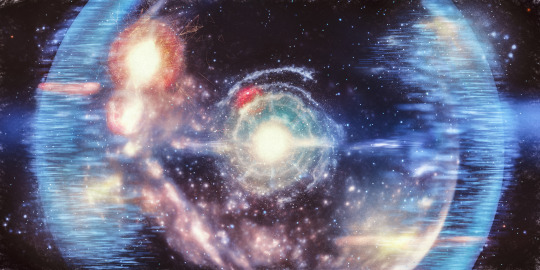
This states that the Universe is infinite in extent, infinitely old and, taken as a whole, it is the same in all directions and at all times in the past and at all times in the future. In other words, the Universe doesn’t evolve or change over time. The theory does acknowledge that change takes place on a smaller scale. If we take a small region of the Universe, such as the neighborhood of the Sun, it does change over time as individual stars burn up their fuel and die, eventually becoming objects such as black dwarfs, neutrons stars and black holes. The Steady State state theory proposes that new stars are continually created all the time at the rate needed to replace the stars which have used up their fuel and have stopped shining.

So, if we take a large enough region of space, and by large we mean tens of millions of light years across, the average amount of light emitted doesn’t change over time. Arguments in favor of the Steady State Hypothesis include the apparent time-scale problem raised by the observed rate of cosmic expansion (aka. the Hubble Constant or the Hubble-Lemaitre law). Based on Hubble’s observations of nearby galaxies, he calculated that the Universe was expanding at a velocity that increased systematically with distance.

However, ongoing observations during the 1950s and 1960s steadily led to a buildup of evidence against the Steady State Hypothesis. These included the discovery of bright radio sources (aka. quasars and radio galaxies) which were discovered in distant galaxies but not those closest to us – indicating that many galaxies became “radio-quiet” over time. By 1961, surveys of radio sources allowed for statistical analyses to be made, which ruled out the possibility that bright radio galaxies were uniformly distributed. Another major argument against the Steady State Hypothesis was the discovery of the Cosmic Microwave Background (CMB) in 1964, which the Big Bang model predicted.
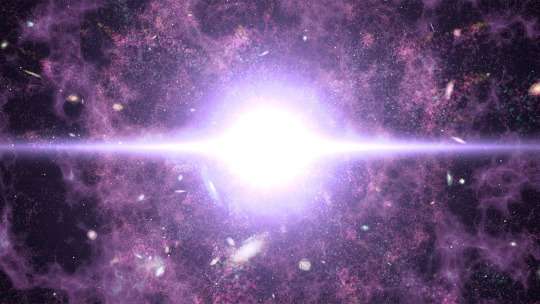
Combined with the absence of a gamma-ray background and pervasive clouds of x-ray emitting gas, the Big Bang model became widely accepted by the 1960s. By the 1990s, observations with the Hubble Space Telescope and other observatories also discovered that cosmic expansion has not been consistent over time. During the last three billion years, in fact, it has been accelerating.
COMING UP!!
(Saturday, March 6th ,2021)
“WHAT IS THE PULSATING THEORY??”
#Astronomy#astrophysics#astrophotography#outer space#spacecraft#space#universe#alternate universe#Parallel Universe#white universe#the flash#nasa 2020#NASA
67 notes
·
View notes
Text
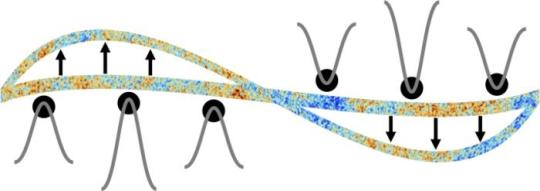
The case of the missing black holes
New model aims to explain the lack of miniature black holes in the early universe
Researchers at the Research Center for the Early Universe (RESCEU) and Kavli Institute for the Physics and Mathematics of the Universe (Kavli IPMU, WPI) at the University of Tokyo have applied the well-understood and highly verified quantum field theory, usually applied to the study of the very small, to a new target, the early universe. Their exploration led to the conclusion that there ought to be far fewer miniature black holes than most models suggest, though observations to confirm this should soon be possible. The specific kind of black hole in question could be a contender for dark matter.
The study of the universe can be a daunting thing, so let’s make sure we’re all on the same page. Though details are fuzzy, the general consensus amongst physicists is that the universe is about 13.8 billion years old, began with a bang, expanded rapidly in a period called inflation, and somewhere along the line went from being homogenous to containing detail and structure. Most of the universe is empty, but despite this, it appears to be significantly heavier than can be explained by what we can see — we call this discrepancy dark matter, and no one knows what this might be, but evidence is building that it might be black holes, specifically old ones.
“We call them primordial black holes (PBH), and many researchers feel they are a strong candidate for dark matter, but there would need to be plenty of them to satisfy that theory,” said graduate student Jason Kristiano. “They are interesting for other reasons too, as since the recent innovation of gravitational wave astronomy, there have been discoveries of binary black hole mergers, which can be explained if PBHs exist in large numbers. But despite these strong reasons for their expected abundance, we have not seen any directly, and now we have a model which should explain why this is the case.”
Kristiano and his supervisor, Professor Jun’ichi Yokoyama, presently the director of Kavli IPMU and RESCEU, have extensively explored the various models for PBH formation, but found that the leading contenders do not align with actual observations of the cosmic microwave background (CMB), which is sort of like a leftover fingerprint from the Big Bang explosion marking the beginning of the universe. And if something disagrees with solid observations, it either cannot be true or can only paint part of a picture at best. In this case, the team used a novel approach to correct the leading model of PBH formation from cosmic inflation so it better aligns with current observations and could be further verified with upcoming observations by terrestrial gravitational wave observatories around the world.
“At the beginning, the universe was incredibly small, much smaller than the size of a single atom. Cosmic inflation rapidly expanded that by 25 orders of magnitude. At that time, waves traveling through this tiny space could have had relatively large amplitudes but very short wavelengths. What we have found is that these tiny but strong waves can translate to otherwise inexplicable amplification of much longer waves we see in the present CMB,” said Yokoyama. “We believe this is due to occasional instances of coherence between these early short waves, which can be explained using quantum field theory, the most robust theory we have to describe everyday phenomena such as photons or electrons. While individual short waves would be relatively powerless, coherent groups would have the power to reshape waves much larger than themselves. This is a rare instance of where a theory of something at one extreme scale seems to explain something at the opposite end of the scale.”
If, as Kristiano and Yokoyama suggest, early small-scale fluctuations in the universe do affect some of the larger-scale fluctuations we see in the CMB, it might alter the standard explanation of coarse structures in the universe. But also, given we can use measurements of wavelengths in the CMB to effectively constrain the extent of corresponding wavelengths in the early universe, it necessarily constrains any other phenomena that might rely on these shorter, stronger wavelengths. And this is where the PBHs come back in.
“It is widely believed that the collapse of short but strong wavelengths in the early universe is what creates primordial black holes,” said Kristiano. “Our study suggests there should be far fewer PBHs than would be needed if they are indeed a strong candidate for dark matter or gravitational wave events.”
At the time of writing, the world’s gravitational wave observatories, LIGO in the U.S., Virgo in Italy and KAGRA in Japan, are in the midst of an observation mission which aims to observe the first small black holes, likely PBHs. In any case, the results should offer the team solid evidence to help them refine their theory further.
4 notes
·
View notes
Text
What Can We Learn from the Universe’s Baby Picture?
If you look at your baby photos, you might see hints of the person you are today — a certain look in the eyes, maybe the hint of your future nose or ears. In the same way, scientists examine the universe’s “baby picture” for clues about how it grew into the cosmos we know now. This baby photo is the cosmic microwave background (CMB), a faint glow that permeates the universe in all directions.
In late September, NASA plans to launch a balloon-based astronomical observatory from Fort Sumner, New Mexico, to study the universe’s baby picture. Meet PIPER! The Primordial Inflation Polarization Explorer will fly at the edge of our atmosphere to look for subtle patterns in the CMB.

The CMB is cold. Really, really cold. The average temperature is around minus 455 degrees Fahrenheit. It formed 380,000 years after the big bang, which scientists think happened about 13.8 billion years ago. When it was first discovered, the CMB temperature looked very uniform, but researchers later found there are slight variations like hot and cold spots. The CMB is the oldest light in the universe that we can see. Anything before the CMB is foggy — literally.

Credit: Rob van Hal
Before the CMB, the universe was a fog of hot, dense plasma. (By hot, we’re talking about 500 million degrees F.) That’s so hot that atoms couldn’t exist yet – there was just a soup of electrons and protons. Electrons are great at deflecting light. So, any light that existed in the first few hundred thousand years after the big bang couldn’t travel very far before bouncing off electrons, similar to the way a car’s headlights get diffused in fog.
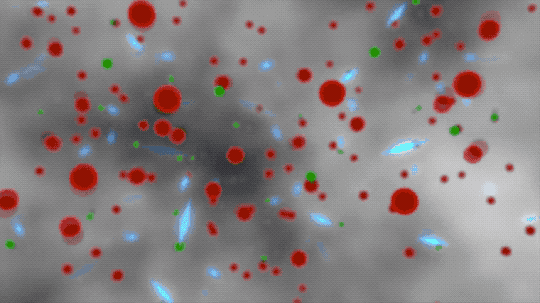
After the big bang, the universe started expanding rapidly in all directions. This expansion is still happening today. As the universe continued to expand, it cooled. By the time the universe reached its 380,000th birthday, it had cooled enough that electrons and protons could combine into hydrogen atoms for the first time. (Scientists call this era recombination.) Hydrogen atoms don’t deflect light nearly as well as loose electrons and the fog lifted. Light could now travel long distances across the universe.
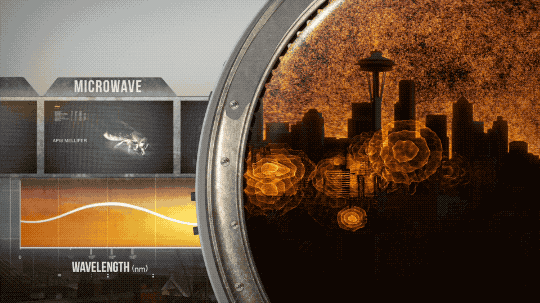
The light we see in the CMB comes from the recombination era. As it traveled across the universe, through the formation of stars and galaxies, it lost energy. Now we observe it in the microwave part of the electromagnetic spectrum, which is less energetic than visible light and therefore invisible to our eyes. The first baby photo of the CMB – really, a map of the sky in microwaves – came from our Cosmic Background Explorer, which operated from 1989 to 1993.

Why are we so interested in the universe’s baby picture? Well, it’s helped us learn a lot about the structure of the universe around us today. For example, the Wilkinson Microwave Anisotropy Probe produced a detailed map of the CMB and helped us learn that the universe is 68 percent dark energy, 27 percent dark matter and just 5 percent normal matter — the stuff that you and stars are made of.

Right after the big bang, we’re pretty sure the universe was tiny. Really tiny. Everything we see today would have been stuffed into something smaller than a proton. If the universe started out that small, then it would have followed the rules of quantum mechanics. Quantum mechanics allows all sorts of strange things to happen. Matter and energy can be “borrowed” from the future then crash back into nothingness. And then cosmic inflation happened and the universe suddenly expanded by a trillion trillion times.

All this chaos creates a sea of gravitational waves. (These are called “primordial” gravitational waves and come from a different source than the gravitational waves you may have heard about from merging neutron stars and black holes.) The signal of the primordial gravitational waves is a bit like white noise, where the signal from merging dead stars is like a whistle you can pick up over the noise.
These gravitational waves filled the baby universe and created distinct patterns, called B-mode polarization, in the CMB light. These patterns have handedness, which means even though they’re mirror images of each other, they’re not symmetrical — like trying to wear a left-hand glove on your right hand. They’re distinct from another kind of polarization called E-mode, which is symmetrical and echoes the distribution of matter in the universe.
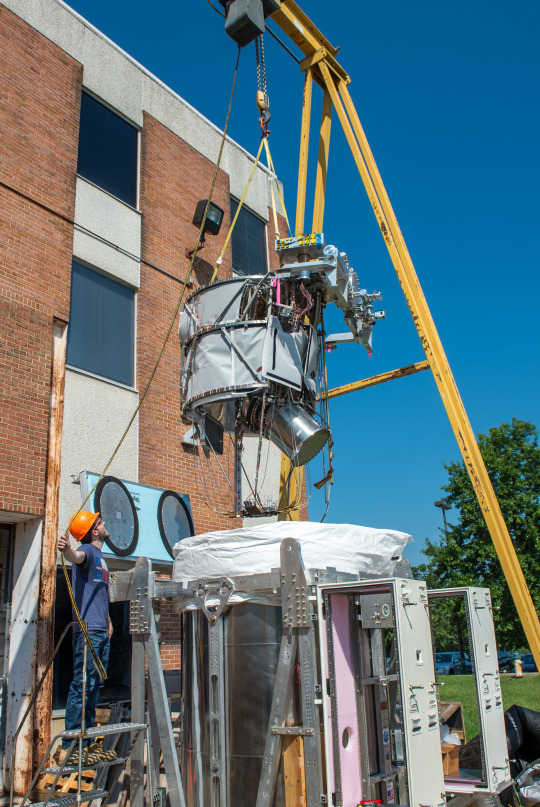
That’s where PIPER comes in. PIPER’s two telescopes sit in a hot-tub-sized container of liquid helium, which runs about minus 452 degrees F. It’ll look at 85 percent of the sky and is extremely sensitive, so it will help us learn even more about the early days of the universe. By telling us more about polarization and those primordial gravitational waves, PIPER will help us understand how the early universe grew from that first baby picture.
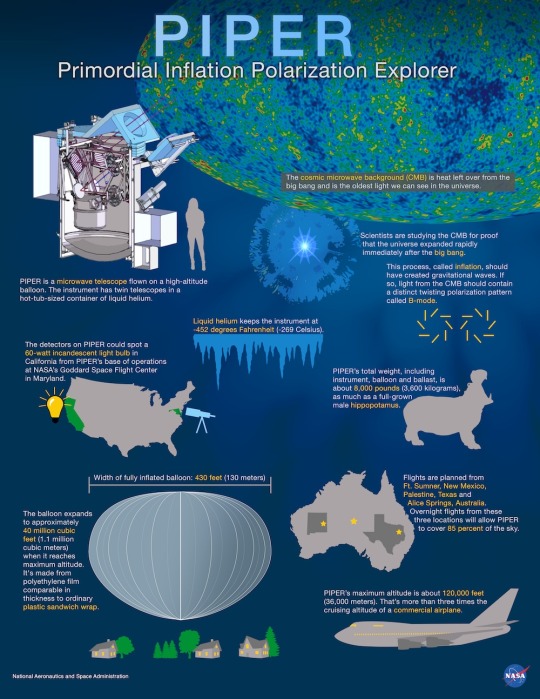
PIPER’s first launch window in Fort Sumner, New Mexico, is in late September. When it’s getting ready to launch, you’ll be able to watch the balloon being filled on the Columbia Scientific Balloon Facility website. Follow NASA Blueshift on Twitter or Facebook for updates about PIPER and when the livestream will be available.
Make sure to follow us on Tumblr for your regular dose of space: http://nasa.tumblr.com.
3K notes
·
View notes
Text
'Best view ever': observatory will map Big Bang's afterglow in new detail - Nature
“It will be the best view of the CMB that we've ever had,” says Jo Dunkley, a cosmologist at Princeton University in New Jersey and one of the leading …
View On WordPress
0 notes
Link
The IceCube Neutrino Observatory, operated by the University of Wisconsin-Madison (UW-M), located at the Amundsen–Scott South Pole Station in Antarctica, is one of the most ambitious neutrino observatories in the world. Behind this observatory is the IceCube Collaboration, an international group of 300 physicists from 59 institutions in 14 countries. Relying on a cubic kilometer of ice to shield from external interference, this observatory is dedicated to the search for neutrinos. These nearly massless subatomic particles are among the most abundant in the Universe and constantly pass through normal matter. By studying these particles, scientists hope to gain insight into some of the most violent astrophysical sources – such as supernovae, gamma-ray bursts, merging black holes and neutron stars, etc. The group of scientists tasked with advising the U.S. government on particle physics research is known as the Particle Physics Project Prioritization Panel (P5). In a recent draft report, “Pathways to Innovation and Discovery in Particle Physics,” the P5 team recommended a planned expansion of IceCube. This recommendation is one of several that define the future of astrophysics and particle physics research. The report also recommends support for a separate neutrino experiment based in Illinois called the Deep Underground Neutrino Experiment, along with multiple projects at CERN’s Large Hadron Collider, the Vera C. Rubin Observatory, the Cherenkov Telescope Array, and the development of next-generation ground-based telescopes to observe the cosmic microwave background (CMB). The P5 advisors include two UW–Madison faculty members, Tulika Bose and Kyle Cranmer, and UW–Madison physicists also hold leading roles in the projects listed above. A view of the IceCube Lab with a starry night sky showing the Milky Way and green auroras. Credit: Yuya Makino, IceCube/NSF Bose is an experimental particle physicist who works on the Compact Muon Solenoid experiment at the LHC. Her research is focused on the search for exotic particles, Dark Matter, and Standard Model measurements. Cranmer’s research is similarly focused on the search for exotic particles and physics beyond the Standard Model, which included the ATLAS experiment at the LHC. Together with their P5 colleagues, the two spent much of the last year assessing the future of particle physics and recommending projects that would help advance the field. One of the chief concerns of the P5 panel is how the federal government could maximize the limited funding it allocates to particle physics research over the next decade. This is one of the main reasons for the recommended IceCube expansion, colloquially named ICECube-Gen2. As they indicate in their report, an upgrade to the current observatory would be a relatively cost-effective way to improve the scientific community’s ability to detect and analyze neutrinos: “IceCube-Gen2 also has a strong science case in multi-messenger astrophysics together with gravitational wave observatories… The South Pole, a unique site that enables the world-leading science of CMB-S4 and IceCube-Gen2, must be maintained as a premier site of science to allow continued US leadership in these areas.” “Using new technology and taking advantage of the brilliant ice that we can model with ever higher precision, IceCube-Gen2 can expand the detection volume by a factor of eight for a cost comparable to IceCube,” said Albrecht Karle, a UW–Madison physics professor who is leading the IceCube upgrade in a UW-M press release. In addition to supporting an IceCube expansion and other major experiments, the panel recommended an improved funding balance between projects of all sizes, a more aggressive research and development program that could lead to a next-generation particle accelerator, and broadening the nation’s advanced technology workforce. Bose indicated that she is particularly excited by the prospect of a new particle accelerator, which could potentially be located in the U.S. “I am excited by the bold long-term vision presented in the P5 report,” she said. “Such a collider would be an unparalleled global facility that will provide new insights into the mysteries of our quantum universe.” The P5 panel’s recommendations are now being reviewed by the High Energy Physics Advisory Panel (HEPAP), part of the U.S. Department of Energy (DoE), which is scheduled to meet on December 8th to discuss the recommendations. An online version of the P5 report can be found here on the DoE’s website, and a 2-page summary can be found on the HEPAP site here. Further Reading: University of Wisconsin-Madison The post Scientists are Recommending IceCube Should be Eight Times Bigger appeared first on Universe Today.
0 notes
Text
Active galaxies point to new physics of cosmic expansion
ESA - Planck Mission patch / ESA - XMM-Newton Mission patch.
28 January 2019
Investigating the history of our cosmos with a large sample of distant ‘active’ galaxies observed by ESA’s XMM-Newton, a team of astronomers found there might be more to the early expansion of the Universe than predicted by the standard model of cosmology.
According to the leading scenario, our Universe contains only a few percent of ordinary matter. One quarter of the cosmos is made of the elusive dark matter, which we can feel gravitationally but not observe, and the rest consists of the even more mysterious dark energy that is driving the current acceleration of the Universe’s expansion.
Measuring the expansion of the Universe
This model is based on a multitude of data collected over the last couple of decades, from the cosmic microwave background, or CMB – the first light in the history of the cosmos, released only 380 000 years after the big bang and observed in unprecedented detail by ESA’s Planck mission – to more ‘local’ observations. The latter include supernova explosions, galaxy clusters and the gravitational distortion imprinted by dark matter on distant galaxies, and can be used to trace cosmic expansion in recent epochs of cosmic history – across the past nine billion years.
A new study, led by Guido Risaliti of Università di Firenze, Italy, and Elisabeta Lusso of Durham University, UK, points to another type of cosmic tracer – quasars – that would fill part of the gap between these observations, measuring the expansion of the Universe up to 12 billion years ago.
Quasars are the cores of galaxies where an active supermassive black hole is pulling in matter from its surroundings at very intense rates, shining brightly across the electromagnetic spectrum. As material falls onto the black hole, it forms a swirling disc that radiates in visible and ultraviolet light; this light, in turn, heats up nearby electrons, generating X-rays.
Supermassive black hole
Three years ago, Guido and Elisabeta realised that a well-known relation between the ultraviolet and X-ray brightness of quasars could be used to estimate the distance to these sources – something that is notoriously tricky in astronomy – and, ultimately, to probe the expansion history of the Universe.
Astronomical sources whose properties allow us to gauge their distances are referred to as ‘standard candles’.
The most notable class, known as ‘type-Ia’ supernova, consists of the spectacular demise of white dwarf stars after they have over-filled on material from a companion star, generating explosions of predictable brightness that allows astronomers to pinpoint the distance. Observations of these supernovas in the late 1990s revealed the Universe’s accelerated expansion over the last few billion years.
“Using quasars as standard candles has great potential, since we can observe them out to much greater distances from us than type-Ia supernovas, and so use them to probe much earlier epochs in the history of the cosmos,” explains Elisabeta.
With a sizeable sample of quasars at hand, the astronomers have now put their method into practice, and the results are intriguing.
XMM-Newton
Digging into the XMM-Newton archive, they collected X-ray data for over 7000 quasars, combining them with ultraviolet observations from the ground-based Sloan Digital Sky Survey. They also used a new set of data, specially obtained with XMM-Newton in 2017 to look at very distant quasars, observing them as they were when the Universe was only about two billion years old. Finally, they complemented the data with a small number of even more distant quasars and with some relatively nearby ones, observed with NASA’s Chandra and Swift X-ray observatories, respectively.
“Such a large sample enabled us to scrutinise the relation between X-ray and ultraviolet emission of quasars in painstaking detail, which greatly refined our technique to estimate their distance,” says Guido.
The new XMM-Newton observations of distant quasars are so good that the team even identified two different groups: 70 percent of the sources shine brightly in low-energy X-rays, while the remaining 30 percent emit lower amounts of X-rays that are characterised by higher energies. For the further analysis, they only kept the earlier group of sources, in which the relation between X-ray and ultraviolet emission appears clearer.
“It is quite remarkable that we can discern such level of detail in sources so distant from us that their light has been travelling for more than ten billion years before reaching us,” says Norbert Schartel, XMM-Newton project scientist at ESA.
After skimming through the data and bringing the sample down to about 1600 quasars, the astronomers were left with the very best observations, leading to robust estimates of the distance to these sources that they could use to investigate the Universe’s expansion.
Supernova and quasar data
“When we combine the quasar sample, which spans almost 12 billion years of cosmic history, with the more local sample of type-Ia supernovas, covering only the past eight billion years or so, we find similar results in the overlapping epochs,” says Elisabeta.
“However, in the earlier phases that we can only probe with quasars, we find a discrepancy between the observed evolution of the Universe and what we would predict based on the standard cosmological model.”
Looking into this previously poorly explored period of cosmic history with the help of quasars, the astronomers have revealed a possible tension in the standard model of cosmology, which might require the addition of extra parameters to reconcile the data with theory.
“One of the possible solutions would be to invoke an evolving dark energy, with a density that increases as time goes by,” says Guido.
Incidentally, this particular model would also alleviate another tension that has kept cosmologists busy lately, concerning the Hubble constant – the current rate of cosmic expansion. This discrepancy was found between estimates of the Hubble constant in the local Universe, based on supernova data – and, independently, on galaxy clusters – and those based on Planck’s observations of the cosmic microwave background in the early Universe.
Planck
“This model is quite interesting because it might solve two puzzles at once, but the jury is definitely not out yet and we’ll have to look at many more models in great detail before we can solve this cosmic conundrum,” adds Guido.
The team is looking forward to observing even more quasars in the future to further refine their results. Additional clues will also come from ESA’s Euclid mission, scheduled for a 2022 launch to explore the past ten billion years of cosmic expansion and investigate the nature of dark energy.
“These are interesting times to investigate the history of our Universe, and it’s exciting that XMM-Newton can contribute by looking at a cosmic epoch that had remained largely unexplored so far,” concludes Norbert.
Notes for editors:
“Cosmological constraints from the Hubble diagram of quasars at high redshifts” by G. Risaliti & E. Lusso is published in Nature Astronomy: https://www.nature.com/articles/s41550-018-0657-z
Related links:
ESA’s XMM-Newton: http://www.esa.int/Our_Activities/Space_Science/XMM-Newton_overview
ESA’s Planck: http://www.esa.int/Our_Activities/Space_Science/Planck
ESA’s Euclid: http://sci.esa.int/euclid/
Text, Credits: ESA/Markus Bauer/Norbert Schartel/Centre for Extragalactic Astronomy/Elisabeta Lusso/Università di Firenze/INAF – Osservatorio Astrofisico di Arcetri/Guido Risaliti/Images: ESA (artist's impression and composition); NASA/ESA/Hubble (background galaxies); CC BY-SA 3.0 IGO/C. Carreau/Courtesy of Elisabeta Lusso & Guido Risaliti (2019).
Greetings, Orbiter.ch
Full article
48 notes
·
View notes
Link
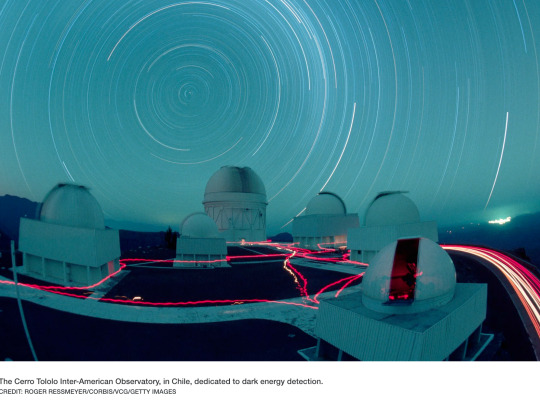
An extensive analysis of four different phenomena within the universe points the way to understanding the nature of dark energy, a collaboration between more than 100 scientists reveals.
Dark energy – the force that propels the acceleration of the expanding universe – is a mysterious thing. Its nature, writes telescope scientist Timothy Abbott from the Cerro Tololo Inter-American Observatory, in Chile, and colleagues, “is unknown, and understanding its properties and origin is one of the principal challenges in modern physics”.
Indeed, there is a lot at stake. Current measurements indicate that dark energy can be smoothly incorporated into the theory of general relativity as a cosmological constant; but, the researchers note, those measurements are far from precise and incorporate a wide range of potential variations.
“Any deviation from this interpretation in space or time would constitute a landmark discovery in fundamental physics,” they note.
Thee heart of the problem, of course, is that dark nature is observable only indirectly, by its effects.
These fall into two categories. First, it deforms galactic architectures through accelerating the expansion of the universe. Second, it suppresses growth in some parts of the cosmic structure.
However, it is not the only force that can produce such results, and the danger thus always exists that what is assumed to be evidence of dark matter activity may in fact be something else altogether.
Current approaches to measuring dark matter are problematic. All of them begin with the cosmic microwave background (CMB), the relic radiation that fills space, generated just 400,000 years after the Big Bang.
At that point in the history of the universe the influence of dark matter was minimal. It increased significantly as spacetime expanded ever more and ever faster.
The second pillar for measuring it, thus, comprises observations of “low-redshift” phenomena – wavelengths stretched over vast distances, allowing calculations of conditions within the universe the past several billion years.
Combining the two measurements and then extrapolating forwards to the present day, Abbott and colleagues note, “can be a powerful test of our models, but it requires precise, independent constraints from low-redshift experiments”.
It follows, then, that any increase in the precision of low-redshift measurements will also increase the precision of dark energy calculations, reducing (or perhaps increasing) the chances that a previously undiscovered physics is in play in the universe.
The researchers approach this challenge by invoking a combination of multiple observational probes for low-redshift phenomena – namely, those measuring Type Ia supernova light curves, fluctuations in the density of visible (or “baryonic”) matter, weak gravitational lensing, and galaxy clustering.
To do this, they use the results of the Dark Energy Survey (DES), a collaboration of research institutions in the US, South America and Europe that studies observations made by the Victor M Blanco telescope in Chile, which is fitted with specialised instruments for dark energy detection.
Presenting the first tranche of results from the survey, Abbott and colleagues reveal progress towards constraining the nature of dark energy.
The DES findings, they report, absolutely – and independent of CMB-based research – rule out a universe in which dark energy doesn’t exist. They also report that the results suggest the universe is spatially flat, and derive a tighter constraint on the density of baryon matter.
These results, they suggest, constrain the state of “of dark energy and its energy density in the Universe” … “to a precision that is almost a factor of three better than the 7 previous best single-experiment result from the CMB”.
Further planned DES surveys, they conclude, will likely sharpen up knowledge of the impact of dark energy in the universe by orders of magnitude.
The research is soon to be published in the journal Science, and is currently available on the preprint server arXiv.
Phroyd
6 notes
·
View notes